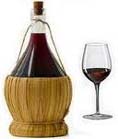Growing, Drying and Using Herbs - 2
from Italian Traditional Food
More about Growing, Drying and Using
Herbs
Check out these great Italian ideas at Amazon for Italian food and kitchen ideas.
<<
Previous Page 2 Next >>
Continuing the short article on
growing, drying and using herbs... .
Here are listed more of the common herbs
Parsley
Cont.....
It is one of the three ingredients of a bouquet garni. Use the
stalks for this as they have the most flavour, and use the leaves for chopping.
Freshly chopped, but not too finely, and sprinkled thickly over such dishes ad egg mayonnaise and
fish cooked in most ways, it gives a wonderful flavour. Fried with fish, it is delicious.
Parsley takes a long time
to grow and is slow in germinating, so for those who are impatient, it is wise to buy parsley plants in the spring
from a nurseryman. Parsley is not worth drying as it can be bought (or picked from the garden) all the year round.
Though a biennial, parsley is best treated as an annual and fresh plants put in every
year.
Rosemary
A bush rather than a plant, this perennial herb is not always
associated with use in the kitchen. Indeed, being strong and pungent, it should be used in the spray, or a few of
the needle-like leaves can be stripped from the stem and used whole. A few cooked whole with sauté potatoes give a
delicious flavour. Put a spray in the roasting tin when cooking chicken or lamb in the oven.
Sage
This perennial herb is the one most
associated with goose, duck or rich meats. It is strong in flavour, so 3-4 leaves are usually enough for a
stuffing. It can also be used to flavour crab-apple or gooseberry jelly.
Savory
A useful herb that has an aromatic flavour similar to
marjoram. It has a dark green, pointed leaf and it is especially suited for
flavouring broad beans. There are two varieties,
the annual summer savory, and perennial winter savory, the latter being more usually home grown.
Tarragon
This is a perennial which is best home grown as it is not easily
obtainable in shops. When buying plants make sure to get the right kind, which is the French variety, with its
faint flavour of aniseed and a grey-green, slightly pointed leaf when full grown. "Russian" tarragon is frequently
mistaken for this variety but it is green and rank in comparison and has no scent at all.
This herb, which goes particularly
well with chicken, fish and eggs, is delicious in flavour. It also makes an aromatic vinegar for use in salads and
sauces.
Thyme
This is a perennial herb; the most commonly used varieties are the
black and lemon thyme. The former is distinguished by its narrow leaf, the latter by a broader and brighter green
leaf and a strong lemon smell.
Thyme is also used in a bouquet garni and chopped in all savoury
stuffings. It dries well.
How to dry herbs
This is a simple and easy job where only a small quantity of dried
herbs is needed for use in the kitchen.
The leaves should be picked before the plants flower (when seeds
have to be gathered they must, naturally, be left until much later). The quicker the leaves can be dried the
better.
Gather the sprays or leaves when quite dry (no rain or dew on
them). Spread them out on sheets of paper, lay these on cake racks or wire trays and lay them in the cool oven of a
solid fuel cooker for 12 - 24 hours. If you don't
have a cooker of this type, use a cool gas or electric oven at 225F or Gas Mark 1/2.
When dry and brittle, crumble the leaves between the fingers or
sift through a wire strainer.
Store herbs in small, clean, dry jars and
keep in a dark cupboard as this will help to preserve their colour.
Page 3 of this Italian Traditional Food article on
herbs can be found on the next page.
<<
Previous Page 2 Next >>

Copyright © 2009 -
. All Rights Reserved Worldwide. Italian Traditional Food
You may not reprint articles from this website
without the written permission of the site owner.
Disclaimer: Articles on this
Website are provided for information purposes only. Italiantraditionalfood.com does not accept any responsibility
or liability for the use or misuse of the article content on this site or reliance by any person on the site's
contents.
| 


 Digg
Digg Stumbleupon
Stumbleupon Google Bookmarks
Google Bookmarks Delicious
Delicious Twitter
Twitter Facebook
Facebook Yahoo My Web
Yahoo My Web Reddit
Reddit